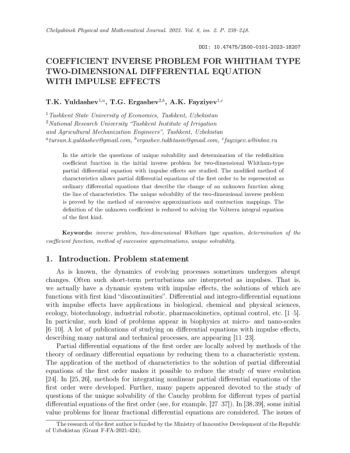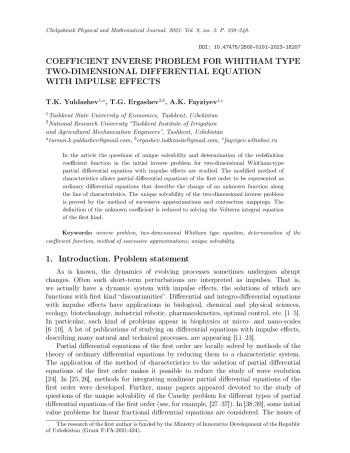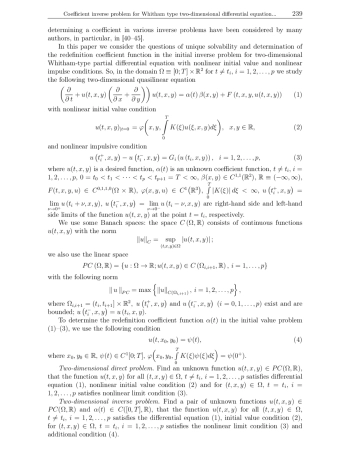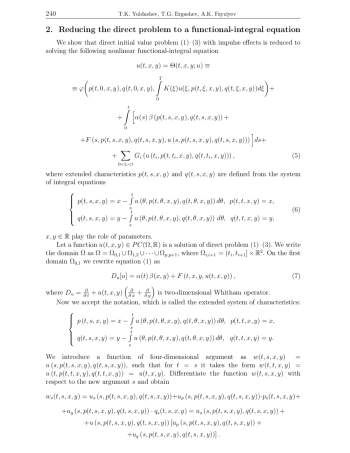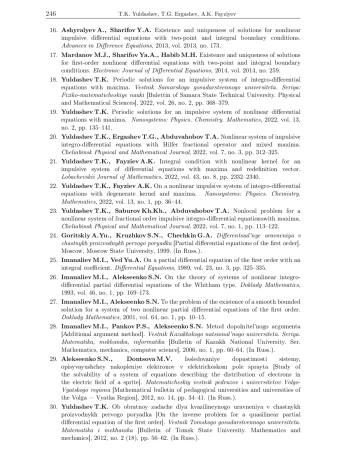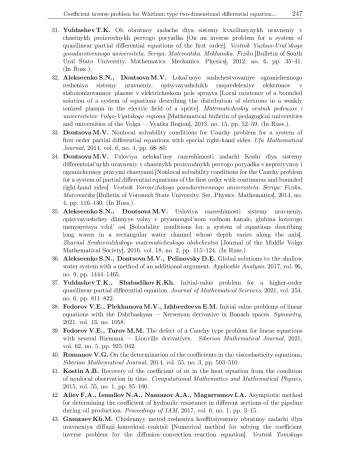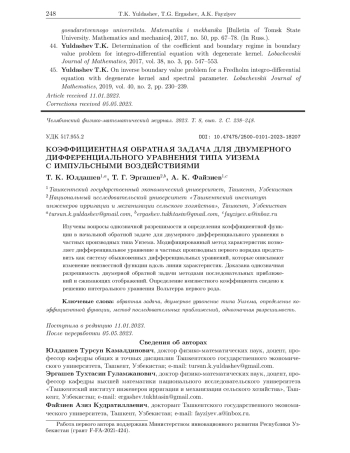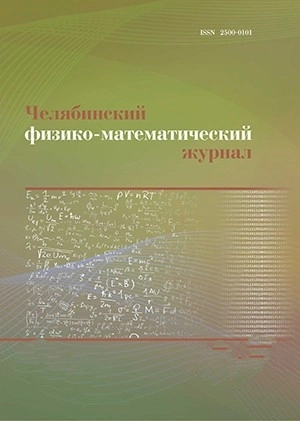In the article the questions of unique solvability and determination of the redefinition coefficient function in the initial inverse problem for two-dimensional Whitham-type partial differential equation with impulse effects are studied. The modified method of characteristics allows partial differential equations of the first order to be represented as ordinary differential equations that describe the change of an unknown function along the line of characteristics. The unique solvability of the two-dimensional inverse problem is proved by the method of successive approximations and contraction mappings. The definition of the unknown coefficient is reduced to solving the Volterra integral equation of the first kind.
Идентификаторы и классификаторы
As is known, the dynamics of evolving processes sometimes undergoes abrupt changes. Often such short-term perturbations are interpreted as impulses. That is, we actually have a dynamic system with impulse effects, the solutions of which are functions with first kind “discontinuities”. Differential and integro-differential equations with impulse effects have applications in biological, chemical and physical sciences, ecology, biotechnology, industrial robotic, pharmacokinetics, optimal control, etc. [1–5]. In particular, such kind of problems appear in biophysics at micro- and nano-scales [6–10]. A lot of publications of studying on differential equations with impulse effects, describing many natural and technical processes, are appearing [11–23].
Список литературы
1. Halanay A., Wexler D. Teoria calitativa a sistemelor cu impulsuri. Bucuresti, Editura Academiei Republicii Socialiste Romania, 1968.
2. Lakshmikantham V., Bainov D.D., Simeonov P.S. Theory of Impulsive Differential Equations. Singapore, World Scientific, 1989.
3. Samoilenko A.M., Perestyk N.A. Impulsive Differential Equations. Singapore, World Scientific, 1995.
4. Benchohra M., Henderson J., Ntouyas S.K. Impulsive Differential Equations and Inclusions. New York, Hindawi Publ., 2006.
5. Perestyk N.A., Plotnikov V.A., Samoilenko A.M., Skripnik N.V. Differential Equations with Impulse Effect: Multivalued Right-Hand Sides with Discontinuities. Berlin, Walter de Gruter Co., 2011.
6. Catlla J., Schaeffer D.G., Witelski Th.P., Monson E.E., Lin A.L. On spiking models for synaptic activity and impulsive differential equations. SIAM Review, 2008, vol. 50, no. 3, pp. 553-569.
7. Stamova I., Stamov G. Impulsive biological models. In: Applied Impulsive Mathematical Models. Springer, Cham, 2016.
8. Fedorov E.G. Properties of an oriented ring of neurons with the Fitzhugh - Nagumo model. Nanosystems: Physics, Chemistry, Mathematics, 2021, vol. 12, no. 5, pp. 553-562. EDN: JOUUKX
9. Fedorov E.G., Popov I.Yu. Analysis of the limiting behavior of a biological neurons system with delay. Journal of Physics: Conference Series, 2021, vol. 2086, no. 012109. EDN: KRLFVV
10. Fedorov E.G., Popov I.Yu. Hopf bifurcations in a network of Fitzhigh - Nagumo biological neurons.International Journal of Nonlinear Sciences and Numerical Simulation, 26.11.2021.
11. Anguraj A., Arjunan M.M. Existence and uniqueness of mild and classical solutions of impulsive evolution equations. Electronic Journal of Differential Equations, 2005, no. 111.
12. Bin L., Xinzhi L., Xiaoxin L. Robust global exponential stability of uncertain impulsive systems. Acta Mathematica Scientia, 2005, vol. 25, no. 1, pp. 161-169.
13. Bai Ch., Yang D. Existence of solutions for second-order nonlinear impulsive differential equations with periodic boundary value conditions. Boundary Value Problems (Hindawi Publ.), 2007, vol. 2007, no. 41589.
14. Li M., Han M. Existence for neutral impulsive functional differential equations with nonlocal conditions. Indagationes Mathematcae, 2009, vol. 20, no. 3, pp. 435-451.
15. Ji Sh., Wen Sh. Nonlocal Cauchy problem for impulsive differential equations in Banach spaces.International Journal of Nonlinear Sciences, 2010, vol. 10, no. 1, pp. 88-95.
16. Ashyralyev A., Sharifov Y.A. Existence and uniqueness of solutions for nonlinear impulsive differential equations with two-point and integral boundary conditions. Advances in Difference Equations, 2013, vol. 2013, no. 173.
17. Mardanov M.J., Sharifov Ya.A., Habib M.H. Existence and uniqueness of solutions for first-order nonlinear differential equations with two-point and integral boundary conditions. Electronic Journal of Differential Equations, 2014, vol. 2014, no. 259.
18. Yuldashev T.K. Periodic solutions for an impulsive system of integro-differential equations with maxima. Vestnik Samarskogo gosudarstvennogo universiteta. Seriya: Fiziko-matematicheskiye nauki [Bulettin of Samara State Technical University. Physical and Mathematical Sciences], 2022, vol. 26, no. 2, pp. 368-379.
19. Yuldashev T.K. Periodic solutions for an impulsive system of nonlinear differential equations with maxima. Nanosystems: Physics. Chemistry. Mathematics, 2022, vol. 13, no. 2, pp. 135-141. EDN: BNGDOI
20. Yuldashev T.K., Ergashev T.G., Abduvahobov T.A. Nonlinear system of impulsive integro-differential equations with Hilfer fractional operator and mixed maxima. Cheliabinsk Physical and Mathematical Journal, 2022, vol. 7, no. 3, pp. 312-325.
21. Yuldashev T.K., Fayziev A.K.Integral condition with nonlinear kernel for an impulsive system of differential equations with maxima and redefinition vector. Lobachevskii Journal of Mathematics, 2022, vol. 43, no. 8, pp. 2332-2340. EDN: HQOFMU
22. Yuldashev T.K., Fayziev A.K. On a nonlinear impulsive system of integro-differential equations with degenerate kernel and maxima. Nanosystems: Physics. Chemistry. Mathematics, 2022, vol. 13, no. 1, pp. 36-44. EDN: SHAUGO
23. Yuldashev T.K., Saburov Kh.Kh., Abduvahobov T.A. Nonlocal problem for a nonlinear system of fractional order impulsive integro-differential equationswith maxima. Cheliabinsk Physical and Mathematical Journal, 2022, vol. 7, no. 1, pp. 113-122.
24. Goritskiy A.Yu., Kruzhkov S.N., Chechkin G.A. Differentsial’nye uravneniya v chastnykh proizvodnykh pervogo poryadka [Partial differential equations of the first order]. Moscow, Moscow State University, 1999. (In Russ.).
25. Imanaliev M.I., Ved Yu.A. On a partial differential equation of the first order with an integral coefficient. Differential Equations, 1989, vol. 23, no. 3, pp. 325-335.
26. Imanaliev M.I., Alekseenko S.N. On the theory of systems of nonlinear integrodifferential partial differential equations of the Whitham type. Doklady Mathematics, 1993, vol. 46, no. 1, pp. 169-173.
27. Imanaliev M.I., Alekseenko S.N. To the problem of the existence of a smooth bounded solution for a system of two nonlinear partial differential equations of the first order. Doklady Mathematics, 2001, vol. 64, no. 1, pp. 10-15. EDN: XKVPYB
28. Imanaliev M.I., Pankov P.S., Alekseenko S.N. Metod dopolnitel’nogo argumenta [Additional argument method]. Vestnik Kazakhskogo natsional’nogo universiteta. Seriya. Matematika, mekhanika, informatika [Bulletin of Kazakh National University. Ser. Mathematics, mechanics, computer science], 2006, no. 1, pp. 60-64. (In Russ.).
29. Alekseenko S.N., Dontsova M.V. Issledovaniye dopustimosti sistemy, opisyvayushchey nakopleniye elektronov v elektricheskom pole sprayta [Study of the solvability of a system of equations describing the distribution of electrons in the electric field of a sprite]. Matematicheskiy vestnik pedvuzov i universitetov VolgoVyatskogo regiona [Mathematical bulletin of pedagogical universities and universities of the Volga - Vyatka Region], 2012, no. 14, pp. 34-41. (In Russ.).
30. Yuldashev T.K. Ob obratnoy zadache dlya kvazilineynogo uravneniya v chastnykh proizvodnykh pervogo poryadka [On the inverse problem for a quasilinear partial differential equation of the first order]. Vestnik Tomskogo gosudarstvennogo universiteta. Matematika i mekhanika [Bulletin of Tomsk State University. Mathematics and mechanics], 2012, no. 2 (18), pp. 56-62. (In Russ.). EDN: PAFDTR
31. Yuldashev T.K. Ob obratnoy zadache dlya sistemy kvazilineynykh uravneniy v chastnykh proizvodnykh pervogo poryadka [On an inverse problem for a system of quasilinear partial differential equations of the first order]. Vestnik Yuzhno-Ural’skogo gosudarstvennogo universiteta. Seriya: Matematika. Mekhanika. Fizika [Bulletin of South Ural State University. Mathematics. Mechanics. Physics], 2012, no. 6, pp. 35-41. (In Russ.).
32. Alekseenko S.N., Dontsova M.V. Local existence of a bounded solution of a system of equations describing the distribution of electrons in a weakly ionized plasma in the electric field of a sprite. Mathematical bulletin of pedagogical universities and universities of the Volga - Vyatka Region, 2013, no. 15, pp. 52-59.
33. Dontsova M.V. Nonlocal solvability conditions for Cauchy problem for a system of first order partial differential equations with special right-hand sides. Ufa Mathematical Journal, 2014, vol. 6, no. 4, pp. 68-80. EDN: UGLVZV
34. Dontsova M.V. Nonlocal solvability conditions for the Cauchy problem for a system of partial differential equations of the first order with continuous and bounded right-hand sides. Bulletin of Voronezh State University. Ser. Physics. Mathematics, 2014, no. 4, pp. 116-130. (In Russ.).
35. Alekseenko S.N., Dontsova M.V. Usloviya razreshimosti sistemy uravneniy, opisyvayushchey dlinnyye volny v pryamougol’nom vodnom kanale, glubina kotorogo menyayetsya vdol’ osi [Solvability conditions for a system of equations describing long waves in a rectangular water channel whose depth varies along the axis]. Zhurnal Srednevolzhskogo matematicheskogo obshchestva [Journal of the Middle Volga Mathematical Society], 2016, vol. 18, no. 2, pp. 115-124. (In Russ.). EDN: WEANAP
36. Alekseenko S.N., Dontsova M.V., Pelinovsky D.E. Global solutions to the shallow water system with a method of an additional argument. Applicable Analysis, 2017, vol. 96, no. 9, pp. 1444-1465. EDN: XMVJCP
37. Yuldashev T.K., Shabadikov K.Kh. Initial-value problem for a higher-order quasilinear partial differential equation. Journal of Mathematical Sciences, 2021, vol. 254, no. 6, pp. 811-822. EDN: BMNGBI
38. Fedorov V.E., Plekhanova M.V., Izhberdeeva E.M. Initial value problems of linear equations with the Dzhrbashyan - Nersesyan derivative in Banach spaces. Symmetry, 2021, vol. 13, no. 1058. EDN: PZWFDX
39. Fedorov V.E., Turov M.M. The defect of a Cauchy type problem for linear equations with several Riemann - Liouville derivatives. Siberian Mathematical Journal, 2021, vol. 62, no. 5, pp. 925-942. EDN: TWSPQH
40. Romanov V.G. On the determination of the coefficients in the viscoelasticity equations, Siberian Mathematical Journal, 2014, vol. 55, no. 3, pp. 503-510. EDN: UGODUV
41. Kostin A.B. Recovery of the coefficient of ut in the heat equation from the condition of nonlocal observation in time.Computational Mathematics and Mathematical Physics, 2015, vol. 55, no. 1, pp. 85-100. EDN: UEODPN
42. Aliev F.A., Ismailov N.A., Namazov A.A., Magarramov I.A. Asymptotic method for determining the coefficient of hydraulic resistance in different sections of the pipeline during oil production. Proceedings of IAM, 2017, vol. 6, no. 1, pp. 3-15.
43. Gamzaev Kh.M. Chislennyy metod resheniya koeffitsiyentnoy obratnoy zadachi dlya uravneniya diffuzii-konvektsii-reaktsii [Numerical method for solving the coefficient inverse problem for the diffusion-convection-reaction equation]. Vestnik Tomskogo gosudarstvennogo universiteta. Matematika i mekhanika [Bulletin of Tomsk State University. Mathematics and mechanics], 2017, no. 50, pp. 67-78. (In Russ.). EDN: ZXNYGN
44. Yuldashev T.K. Determination of the coefficient and boundary regime in boundary value problem for integro-differential equation with degenerate kernel. Lobachevskii Journal of Mathematics, 2017, vol. 38, no. 3, pp. 547-553. EDN: SDAARU
45. Yuldashev T.K. On inverse boundary value problem for a Fredholm integro-differential equation with degenerate kernel and spectral parameter. Lobachevskii Journal of Mathematics, 2019, vol. 40, no. 2, pp. 230-239. EDN: CZPQMO
Выпуск
Другие статьи выпуска
The dislocation activity controls the plastic deformation in the most of metallic materials. Mechanical loading with high strain rates or with high strain gradients can lead to either homogeneous nucleation of the dislocation or emission of dislocations from various heterogeneities, such as nanopores and phase precipitates. The dislocation nucleation and emission trigger plasticity, which relaxes the shear component of stresses. In this work, we study the threshold of dislocation emission from nanosized copper inclusions in an aluminum single crystal in comparison with the homogeneous nucleation of dislocations in pure metal. We consider different shapes of inclusions (spherical, cylindrical and cubic) and rather arbitrary axisymmetric deformations by means of molecular dynamics (MD) simulations. For most deformation paths, the copper inclusions substantially reduce the threshold of plasticity incipience, while the inclusions have no effect for some deformation paths with either axial or transverse extension. Depending on the deformation path, the shape of inclusion can either influence the emission threshold or not. Thus, there is a complex dependence of the threshold of plasticity incipience on the deformation path, the presence and the form of copper inclusions. This dependence is approximated by means of an artificial neural network (ANN) trained on the results of MD simulations. The trained ANN can be further applied as a constitutive equation at the level of continuum mechanics.
The paper presents a phenomenological generalized model of a first-order metamagnetic phase transition for the La(Fe, Si)13 compounds in the approximation of localized moments under the simultaneous action of temperature, field and pressure. To achieve the maximum cooling power of magnetic solid-state cooling devices, the Curie temperature of the working bodies should be fine-tuned by two external generalized forces: a magnetic field and pressure. The thermodynamic phenomenological models presented in the literature are mostly focused on the description of the behavior of magnetocaloric materials in the vicinity of phase transition in the absence of external pressure. In turn, the latter provide a significant reduction in the field hysteresis effect by shifting the Curie temperature and expand the working temperature range of the refrigerant. To estimate the required pressure value, a new generalized model was developed that excludes the linear dependence of the phase transition temperature on the volume change and modernizes the form of the magnetic and phonon entropy, taking into account anharmonism. In addition, the equations of state describing the behavior of working bodies underwent a multistimuli cooling cycle were obtained. The model allows estimating the upper limit of the temperature and field hysteresis and predicting the required external pressure to reduce the field hysteresis.
Исследуется отражение СВЧ-волны от слоя композитного материала из диоксида ванадия и диоксида кремния в окрестности фазового перехода полупроводник-металл. Рассчитаны зависимости коэффициента отражения от температуры, объёмной доли диоксида ванадия в композите и толщины слоя композита в области фазового перехода.
Выполнено первопринципное исследование структуры и свойств алмазоподобных углеродных нанотрубок, формируемых в процессе сворачивания алмазоподобного слоя L4. В результате расчётов методом теории функционала плотности установлено, что только алмазоподобные нанотрубки (n,0)L4, имеющие полипризматическую форму, могут устойчиво существовать. Точечная группа симметрии этих нанотрубок - n/mmm. Значение параметра трансляции находится в диапазоне от 1.6224 до 1.6342 ˚A. Молекулярно-динамические расчёты показали, что нанотрубка (5,0)L, имеющая минимальную полную энергию, должна быть устойчивой до 150 К. Изолированная нанотрубка (5,0)L4 обладает высоким значением модуля Юнга (890 ГПа) и шириной запрещённой зоны в 0.6 эВ, характерной для полупроводника. Материал на основе жгутов алмазоподобных нанотрубок (5,0)L4 с плотной упаковкой можно экспериментально идентифицировать при использовании рассчитанной порошковой рентгенограммы.
Построен алгоритм численного решения задачи кавитационного обтекания тела вращения весомой жидкостью. При совпадении направления силы тяжести и направления вертикального потока возникают новые закономерности кавитационных течений, а образующиеся при этом каверны носят название вертикальных каверн. Для вертикальных каверн возможны отрицательные значения числа кавитации, когда давление газов в каверне превосходит статическое давление в окружающей жидкости на уровне схода струй с тела. Для схематизации течения применена обобщённая схема Рябушинского. Метод решения задачи основан на методе потенциала простого слоя, который сводится к решению системы интегральных уравнений. В процессе решения определяются форма каверны и распределение скорости в жидкости в зависимости от числа кавитации и числа Фруда. Определение формы каверны проводится с помощью метода установления. Примеры расчётов приведены для диска и конусов. Выполнена оценка точности расчётов и проведено сравнение с опытными данными.
We consider local derivations on finite-dimensional Jordan algebras. We developed a technique for the description of the vector space of local derivations on an arbitrary low-dimension Jordan algebra. We also give a description of local derivations on some Jordan algebras of dimension four.
Рассматриваются неявные дифференциальные уравнения (бинарные дифференциальные уравнения) вида ap2 + 2bp + c = 0, где a = a(x, y), b = b(x, y), c = c(x, y), p =dxdXdy, причём a(0, 0) = b(0, 0) = c(0, 0) = 0. Показано, что типичное уравнение такого типа формальными заменами координат (x, y) -→ (X, Y ) приводится к формальной нормальной форме (αX + βY + γ(X))P 2 + X + Y = 0, P = dY, где α, β ∈ C \ {0}, γ -формальный ряд по переменной X, γ(0) = 0, γ,(0) = 0.
Рассматривается частный случай специальной функции Фокса. Выписаны интегральное представление, представление в виде степенного ряда, асимптотические формулы. Доказаны формулы дифференцирования целого порядка, рекуррентные и интегральные соотношения.
Исследуются вопросы разрешимости нелинейных обратных задач с зависящим от времени неизвестным элементом для эволюционных уравнений в банаховых пространствах с производными Герасимова - Капуто. Получена теорема о существовании единственного гладкого решения нелинейной задачи для разрешённого относительно старшей дробной производной уравнения с ограниченным оператором в линейной части. Она использована при исследовании вырожденных эволюционных уравнений при условии p-ограниченности пары операторов в линейной части уравнения - при старшей производной и при искомой функции. В случае действия нелинейного оператора в подпространство без вырождения доказано существование единственного гладкого решения, а при независимости нелинейного оператора от элементов подпространства вырождения показано существование единственного обобщённого решения. Полученные абстрактные результаты для вырожденных уравнений использованы при исследовании обратной задачи для модифицированной системы уравнений Соболева с неизвестными коэффициентами при младших дробных производных по времени.
Найдены все неэквивалентные представления алгебры sl2(R) в пространстве векторных полей Vect R2. Для каждого из найденных представлений описаны все обыкновенные дифференциальные уравнения, допускающие данные представления, в терминах базиса дифференциальных инвариантов и операторов инвариантного дифференцирования. Также найдены операторы Казимира соответствующей универсальной обёртывающей алгебры, проинтегрированы уравнения, порождённые оператором Казимира, и доказана алгебраическая независимость операторов инвариантного дифференцирования и оператора Казимира.
Для уравнения четвёртого порядка с постоянными коэффициентами рассмотрена одна краевая задача в прямоугольной области. Единственность решения поставленной задачи доказана методом интегралов энергии. Решение выписано через построенную функцию Грина. При обосновании равномерной сходимости установлено отличие от нуля <малого знаменателя>.
Статистика статьи
Статистика просмотров за 2025 год.
Издательство
- Издательство
- ЧЕЛГУ
- Регион
- Россия, Челябинск
- Почтовый адрес
- 454001, Челябинская обл., г. Челябинск, ул. Братьев Кашириных, д.129
- Юр. адрес
- 454001, Челябинская обл, г Челябинск, Калининский р-н, ул Братьев Кашириных, д 129
- ФИО
- Таскаев Сергей Валерьевич (РЕКТОР)
- E-mail адрес
- rector@csu.ru
- Контактный телефон
- +7 (351) 7419767
- Сайт
- https://www.csu.ru/
